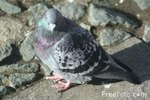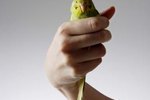
While tiny, brightly colored wild Gouldian finches are endangered in their native Australia, they thrive in captivity. Also known as Lady Gouldian finches, these little birds were named for the wife of explorer John Gould. Sharing your life with Gouldian finches lets you admire their beauty, energy and still-untamed alertness up close.
Gouldian Finches
In the wild, Gouldian finches (Erythrura gouldiae) appear in three basic varieties: black-headed, red-headed and yellow-orange-headed. Their bodies are the same: bluish-purple wings and back, light green neck and a turquoise band across the back of the head. The sides, abdomen and lower breast are yellow fading to white. These variants breed together naturally. In captivity, breeders have developed many new colors in the birds by concentrating on mutations. As in many bird species, the female Gouldian is much plainer than the male. Larger than some finch species, Gouldians mature between 5 and 6 inches long. With good care, these finches can share your life for five to eight years.
Cages
Because Gouldian finches are inherently social creatures, you should never keep a single bird. They don't care much for people -- it's unlikely you'll ever truly "tame" your finches -- but they need the company of their own kind. Purchase the largest cage possible for your Gouldian finches so the little birds have ample room for flying. Ideally, the cage should be longer horizontally than vertically. Unlike with some other pet birds, it's not a good idea to let finches out for free flight in a room. Their cage or aviary is where they receive all of their exercise. Install several natural softwood perches in the cage so your finches have areas of varying heights to land on. Avoid putting the perches above the water or food dishes, so droppings don't soil them. Put some nest boxes in the cage, filled with soft hay or cotton.
Food and Water
Always make sure your birds have access to fresh, clean drinking water. Because they enjoy bathing, put a birdbath or shallow dish in the cage a few times a week for an hour or so, removing it when it becomes dirty. In the wild, Gouldian finches eat various grasses along with sorghum seeds. Development of their habitat and grass destruction is a major reason their wild numbers are in such serious decline. Captive Gouldian finches can eat commercial seed mixes designed for finches, along with fruits and leafy vegetables. Provide your finches with separate feeding bowls for seeds and for fruits and veggies. They love live mealworms, if you want to provide them with a special treat. Your birds require a cuttlebone for calcium, along with crushed oyster or eggshells.
Precautions
In general, Gouldian finches aren't as robust as other breeds of finch.That's partially because they are nervous, easily stressed birds. Once you've situated their cage, don't move it unless absolutely necessary. Gouldian finches require higher temperatures than other birds, ideally between 70 and 75 degrees Fahrenheit. If that's too warm for your home in the winter, they'll probably be just fine as long as they're acclimated to temperature changes. If you don't want your finches to breed, you can keep same-sex birds together. However, unlike mammals, if opposite-sex birds mate and the female lays eggs, you can simply remove them. Don't try to hold a finch unless it's an emergency, as birds of this species find it very stressful.
References
- BirdChannel.com: Gouldian Finch Birds
- Pet University: Gouldian Finches
- eFinch: Gouldian Finch - Chloebia gouldiae (Changing to Erythrura gouldiae)
- Southeast Texas Avian Rescue: The Gouldian Finch
- Finch Niche: Relationships Between Molt, Social Aggression and Disease
- Foreign Bird League: Gouldian Finch Care
Photo Credits
-
Al Barry/Valueline/Getty Images
Writer Bio
Jane Meggitt has been a writer for more than 20 years. In addition to reporting for a major newspaper chain, she has been published in "Horse News," "Suburban Classic," "Hoof Beats," "Equine Journal" and other publications. She has a Bachelor of Arts in English from New York University and an Associate of Arts from the American Academy of Dramatics Arts, New York City.




